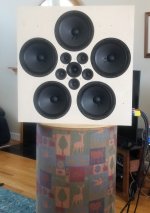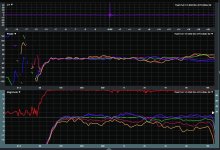True its more like square, since they are so far apart from each other. But even then, still closer to circle formation than what you previously suggested. 😉
At this point I think its ok to add any speaker that is somewhat similar in design, since it looks like we have already discovered all the most pure examples.
At this point I think its ok to add any speaker that is somewhat similar in design, since it looks like we have already discovered all the most pure examples.
Last edited:
Center to center spacing of the drivers.
Will dictate the behavior.
Farther apart, lower crossover.
arranging drivers both vertical and
horizontal. In theory makes both behave equal
off axis vertical/horizontal
crossover be much much lower
otherwise just more combing/ lobing
has its uses for specific needs.
For the most part plenty work arounds.
kinda waste of time, unless you wanna
make a elaborate crossover to get to the
same place a single driver would do.
same issues but x2 as MTM arrangement
either way drivers need to be very very close
together. And no matter how good woodworking
skills are. the actual physical size of the drivers
no matter how close. Just present pointless spacing
issues to work around. The physical size has limits.
can be improved by splayed baffle.
15 to 20 degrees. Will slightly improve
dispersion up to the same 15 to 20 degrees.
Too much splay and another combing notch
appears lower in frequency.
Always tradeoffs.
Will dictate the behavior.
Farther apart, lower crossover.
arranging drivers both vertical and
horizontal. In theory makes both behave equal
off axis vertical/horizontal
crossover be much much lower
otherwise just more combing/ lobing
has its uses for specific needs.
For the most part plenty work arounds.
kinda waste of time, unless you wanna
make a elaborate crossover to get to the
same place a single driver would do.
same issues but x2 as MTM arrangement
either way drivers need to be very very close
together. And no matter how good woodworking
skills are. the actual physical size of the drivers
no matter how close. Just present pointless spacing
issues to work around. The physical size has limits.
can be improved by splayed baffle.
15 to 20 degrees. Will slightly improve
dispersion up to the same 15 to 20 degrees.
Too much splay and another combing notch
appears lower in frequency.
Always tradeoffs.
Yes. Here is an explanation how those Genelec speakers were designed in that aspect. A five way design with a small coaxial speaker in the center enables the lower crossover point for the four mids that are so far apart.
4-5-6…..none of it matters as long as the full array is not linear, you’ll have a near infinite variable transfer function where lobing and combing will result in a very uneven and nasty power reponse…. So in other words, a single mid or D’appolito will outperform this arrangement…..UNLESS……. You settled on 5 units and a Bessel array AND have the time and will to
1. Build the 5 into a circle that’s rotateable on a central axis
2. combine each measured index with 5 sequences variations of the Bessel sequence
3. Spit on the dice while you prototype and hope for the best…….
1. Build the 5 into a circle that’s rotateable on a central axis
2. combine each measured index with 5 sequences variations of the Bessel sequence
3. Spit on the dice while you prototype and hope for the best…….
What the drivers in a circle can achieve (like that Genelec, it's still a circle with a 4 driver spread 😉) is similar horizontal/vertical pattern control, much like what a coax or very close-spaced MTM (think Danley Synergy) can do.
No more flat-baffle ring speakers for me...
Of all the different types I've tried to DIY....this guy, in terms of trying to get best possible on & off-axis Horiz polars over a reasonable area, was the worst.
I guess though, that the good news at least is the vertical polars should be about the same as Horiz. (dunno, didn't bother to measure)
The plot used dark blue 20deg H, as reference tuning axis. Rest are 0-30 deg, 10 deg steps.


Now as for a pyramid-baffle ring radiator ???
Heck yeah, I do believe such be called a Unity horn 😀
Defintely closes down c2c issues vs a flat-baffle...
Of all the different types I've tried to DIY....this guy, in terms of trying to get best possible on & off-axis Horiz polars over a reasonable area, was the worst.
I guess though, that the good news at least is the vertical polars should be about the same as Horiz. (dunno, didn't bother to measure)
The plot used dark blue 20deg H, as reference tuning axis. Rest are 0-30 deg, 10 deg steps.


Now as for a pyramid-baffle ring radiator ???
Heck yeah, I do believe such be called a Unity horn 😀
Defintely closes down c2c issues vs a flat-baffle...
That Genelec uses heavy proprietary DSP……and it’s not been well received in the wildWhat the drivers in a circle can achieve (like that Genelec, it's still a circle with a 4 driver spread 😉) is similar horizontal/vertical pattern control, much like what a coax or very close-spaced MTM (think Danley Synergy) can do.
I can't say if they're any good, never been close to them. Personally I don't mind the use of DSP really, if it's done right(*).
My point is:
Horizontal plot of the 8381a:

Vertical plot of the 8381a:

Pretty sure that was the aim placing those drivers "in a circle". 🙂
They are high SPL monsters to be listened at at a distance. Here's the brochure.
(*)= I use plenty of DSP myself, if only to please me and my family.
In other words; done right to please me/us and I don't have to worry about anyone else.
My point is:
Horizontal plot of the 8381a:
Vertical plot of the 8381a:
Pretty sure that was the aim placing those drivers "in a circle". 🙂
They are high SPL monsters to be listened at at a distance. Here's the brochure.
(*)= I use plenty of DSP myself, if only to please me and my family.
In other words; done right to please me/us and I don't have to worry about anyone else.
Last edited:
The directivity can be very even in these sort of arrangements as long as it is used below a frequency where the lobing becomes an issue.4-5-6…..none of it matters as long as the full array is not linear, you’ll have a near infinite variable transfer function where lobing and combing will result in a very uneven and nasty power reponse…. So in other words, a single mid or D’appolito will outperform this arrangement…..UNLESS……. You settled on 5 units and a Bessel array AND have the time and will to
An example of a simulation I ran a while ago based on this kind of idea.
https://www.diyaudio.com/community/...aker-build-abec-modelling.357792/post-6551783
This forces the central unit to extend low enough and have a pattern to match at the crossover frequency for it to work. I was looking at a large compression driver on a waveguide, Genelec went for a coaxial in a waveguide. The difficulty is in getting the distance between the drivers outputs to be small enough to work with the central driver. The Synergy horn or derivatives make that part easier.
Do you mean that specific Genelec speaker model has a lot of combing and lobing and it has an uneven nasty response? Just checking if I understood correctly.4-5-6…..none of it matters as long as the full array is not linear, you’ll have a near infinite variable transfer function where lobing and combing will result in a very uneven and nasty power reponse….
'
Then who didn't receive it well? Or did you mean that DSP technology in general is not received well by some people?That Genelec uses heavy proprietary DSP……and it’s not been well received in the wild
If that is true, then surely Genelec as a company is going down and their yearly sales must be declining as they have used their DSP solutions for years already. Making that kind of fundamentally faulty speaker and combining it with DSP that people don't even want. If I were you, I would call the design team and offer some basic help to get them to the right track. I think they might have not even designed the speaker, just slapped some components together and that is the result. That is often the case with companies that hastily release their first product.
Last edited:
this guy, in terms of trying to get best possible on & off-axis Horiz polars over a reasonable area, was the worst.
Which crossover frequencies did you have and what were the center to center distances? What about the back, was it open or closed?
I wonder, how would have it worked with a round baffle and not square... In any case, that speaker would be interesting to hear, for sure.
Last edited:
- Home
- Loudspeakers
- Multi-Way
- Midrange drivers in a circle?